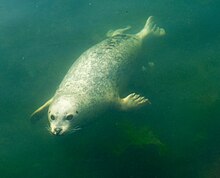Harbour seal (Phoca vitulina richardsi)
If you have visited Fisherman’s Wharf or the Oak Bay Marina, chances are you will have seen a harbour seal or even fed one of them a nice, tasty fish (if the seagulls did not rudely snatch it out of your hands). Seals can be found at all of Victoria’s harbours, usually lounging like its Super Bowl Sunday on rocky reefs, sandbars and boulders. The local species is called the Pacific harbour seal and it belongs to a group of mammals called the pinnipeds which means fin or flipper-footed and which also includes sea lions and walruses.

Harbour seals live in temperate to arctic waters along the coastline of the north Pacific and Atlantic Oceans and tend to remain in the same general area their entire life, usually within a 25 km distance from shore. Harbour seals scatter into small groups during mating season in the early spring to mate underwater, and then give birth in July to August to a single live pup on land. These cute pups weigh around 22 pounds and can crawl and swim within hours of birth (probably to outswim those hungry orcas). Male seals can live up to 20-25 years, and female seals up to 30-35 years. Harbour seals have a thick layer of fat to keep them toasty in the chilly waters.
You can tell seals apart from sea lions because they do not have external ear flaps, they have shorter fur-covered front flippers, they cannot raise their heads or shoulders on land, they move like an inch-worm on land, and in the water they scull with their back flippers and steer with their front flippers making them very agile swimmers. Sea lions, on the other hand, are much more agile on land because they can raise their head and “walk” on both pair of flippers (this is probably why sea lions get all of the marine show gigs). Harbour seals are about 1.2 to 1.6 m in length and weigh approximately 130 to 180 pounds, although some larger adults can grow over 1.8 m and weigh up to 290 pounds! The colour of their fur can be black, brown,tan,gray or silvery white, with a unique pattern of light or dark spots.
Harbour seals eat fish such as sculpins, small flatfishes and rockfishes, greenlings, smelts, perches, hake, herring and salmon. They are also known to eat crustaceans (crayfish, crab, shrimp), molluscs (ostopus and squid), and even ducks! In the Salish Sea, they often feed on a deep-sea fish called hake (which is probably great with Shake and Bake). When looking for food, seals will usually make quick dives of three to seven minutes to depths less than 100m, although, they can remain submerged for up to forty minutes and dive over 400m deep.

Between 1913 and 1964, there was a bounty offered on harbour seals because commercial fisherman thought of them as a threat to their fish stocks. After their numbers declined substantially, the bounties were lifted in the early 1970s and their numbers have rebounded from about 10,000 to at least 105,000 today. In the Salish Sea, there are about 13 seals per kilometre of shoreline (compared to only 2.6 for all of BC’s coastline). Even though the Salish Sea contains only 11% of BC’s total coastline, it supports 37% of all of BC’s harbour seals. Harbour seals (and prey that consume seals such as resident orcas) are threatened by pollution such as organchlorines (PCBs, DDT, dioxins), hydrocarbons (oils, gasoline, solvents) and heavy metals. These debilitating chemicals do not break down easily and are absorbed by smaller organisms which eventaully end up in the stomachs of seals and orcas.
http://vancouverisland.com/things-to-do-and-see/wildlife-viewing/harbour-seals/
https://www.crd.bc.ca/education/our-environment/wildlife-plants/marine-species/harbour-seals
No comments:
Post a Comment